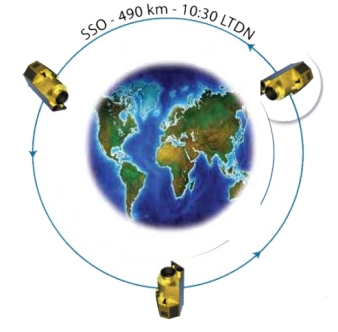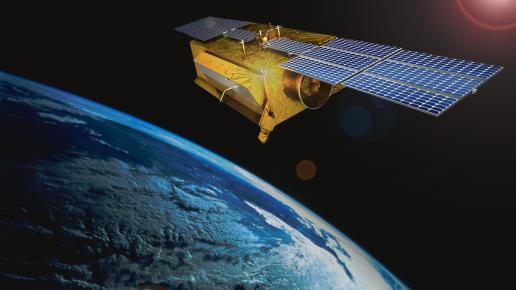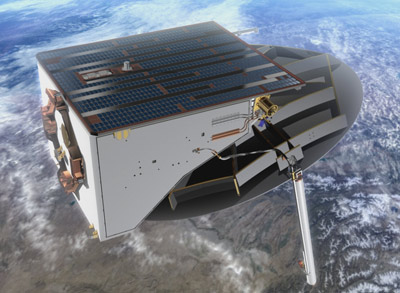German media recently reported the country will procure a new high-resolution optical satellite. According to the press, this satellite will be operated by the BND, Germany’s foreign intelligence service. Such a purchase breaks from the German tradition of operating only radar satellites, under the control of the military, and thus marks an unexpected shift in Berlin’s national security and space policies. To understand its implications better, let’s look a bit more into the details.
The proposed BND satellite is estimated to cost 400M€ and to be launched in 2022. The press mentions that this program is part of a major expansion of Germany’s domestic and foreign intelligence budgets, and is a way to reduce reliance on the United States. It also links it to the late HiROS (High Resolution Optical Satellite) program, that the BND unsuccessfully tried for years to get financed, before it was definitively cancelled around 2012.

HiROS was to be a triplet of 0.5m resolution optical satellites, with 0.8m mirrors. Each of the agile satellites would have had a 12km swath from a 490km orbit. Optionally, they could have carried a 5m resolution thermal infrared imager, and could have used a geostationary data relay satellite to receive their programming and downlink their images in near real-time. On the political side, HiROS was to be used in very close cooperation with the Americans (possibly supplying images to Digital Globe), as numerous leaked US diplomatic cables show.

The HiROS project also aimed at building up a purely German industrial base for optical observation satellites: In Europe, the French have been and arguably still are the leaders in optical earth observation, with Germany and Italy specializing in radar satellites (see History of the French reconnaissance system for details). However, high-resolution radar imagery has proven to be a much more limited market than optical imagery, as can be seen in the graph above, and consequently a pivot to optical is very attractive from an industrial and commercial point of view. To this end, DLR, the German Space agency, has been developing the building blocks of high-performance optical satellites. For instance, it provided the optical and infrared focal planes, and the video processing electronics of the Korean Kompsat 3 and 3A satellites (which provide 0.5m resolution from a 528km orbit). Following this industrial objective, HiROS would have been built by the 100% German OHB company, and not by a division of the French-German Airbus conglomerate.

Moreover, although Germany and France have a sharing agreement of optical and infrared data provided by French spy satellites, the BND wanted to be independent of the French. The German Ministry of Defence apparently did not share the same view. The German government was at the time in talks with the French about sharing data from CSO, the future French optical reconnaissance system. Eventually after the cooperation seemed almost dead, Germany surprisingly agreed in 2015 to fund two thirds of a CSO satellite to the tune of 200M€, with no industrial return in exchange. Presumably, this gives Germany access to around 20% of the CSO output, which will comprise hundreds of 20 to 30cm resolution optical images as well as infrared imagery, starting from 2018. France was strongly opposed to the HiROS program, as it viewed it as a threat to cooperation on CSO.
Consequently, the purchase of an additional optical (and presumably infrared too since the BND was interested in this capability for HiROS) satellite seems to be redundant with buying stakes in CSO: CSO will offer high-revisit, extremely high resolution capabilities that the German system will not be able to match entirely. However, the industrial policy outlined above, as well as the desire to own an independent, sovereign reconnaissance capability explain part of the decision. Organizational and also purely technical points might explain the rest.
On the organizational side, Germany already owns reconnaissance satellites, but these satellites are operated by the German military, not by the BND. In an ideal world, this would not cause any frictions, but the BND may want its own capabilities, to keep its areas of interest secret and to have access to more images. Rivalry between the military and the intelligence services was a major feature of the early history of the US reconnaissance program, and could also be at play here.
On the technical side, the existing German satellite are radar (SAR) satellites: the current SAR-Lupe system has 5 satellites, with at least a 50cm resolution, built by OHB and launched between 2006 and 2008. The program cost was 350M€. It will be replaced by the SARah system around 2018, which will also be a constellation of SAR satellites: a big one with a phased array will be built mainly by Airbus for 350M€, and the other two will be derivative of SAR-Lupe built by OHB. The overall cost is estimated at 800M€.
SAR technology offers several advantages over optical systems: it can see through clouds and at night, the latter being possible with infrared optical systems, but at a lower resolution. It can also see metallic objects very well. Overall, this makes for a responsive system which can guarantee the coverage of an area every day, which is useful from a military point of view: it can and will detect movements of armored vehicles reliably for instance. However, SAR images are very noisy and much harder to interpret than optical images. That means that even with a high resolution, their value for intelligence can be limited. This is supported by the market shares shown above -most commercial customers prefer optical over SAR- and by DLR work on fusing SAR and EO data to fully exploit the potential of SAR. Besides, optical infrared imagery can provide information SAR cannot, such as the heat output of a facility. This might be useful to counter nuclear proliferation for instance: the activity of reactors and enrichment centers can be assessed, and an order of magnitude of their production derived.

All in all, one might speculate that the interest of the BND in optical systems is due to the fact that they could be more useful for long-term, political and strategic intelligence, whereas SAR systems could be have an advantage for operational military intelligence. An illustration of the difference between the two can be found in the recent annexation of Crimea by Russia: while knowing troop positions in Ukraine might be interesting to German authorities, knowing the intent behind the movements, and the corresponding political objectives, could be even more useful and allow to anticipate events instead of reacting. In the challenging security landscape around the Mediterranean and Russia, anticipation may prove essential, and maybe optical systems serve it better than radar.
In conclusion, the German reconnaissance system is undergoing major changes. In the 2006-2016 decade, it consisted of one constellation of radar satellites operated by the military, for a cost of 350M€. In the next decade, it will be made out of a expanded radar system worth 800M€, an optical satellite operated by the foreign intelligence service worth 400M€, and a 200M€ share in the French optical system. In total, that’s 1.4B€, a fourfold increase over the previous spending level. Such a budgetary efforts, along with the diversification of capabilities and the new role of the BND as a satellite operator, signal that Berlin has acknowledged its strategic environment is uncertain, and that it needs more intelligence to better navigate future crises and to be a major actor in its own security and that of Europe.




[…] 2021 • Planned launch of the last CSO satellite. • Planned launch of the last of the 4 Airbus next-gen commercial satellite. • By that date, the French Minstry of Defence plans to acquire 650 satellite images per day, which creates concerns about image analyst workloads. • In the early 2020s, Germany plans to launch up to 3 optical satellites, operated by its intelligence service. More details on the subject are there. […]
LikeLike
[…] strategic autonomy in the space sector. I want to do so, and I will take this position to Brussels, Berlin, all over Europe. We will be a powerful space state in a strong space […]
LikeLike
Hi great rreading your post
LikeLike